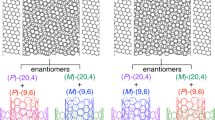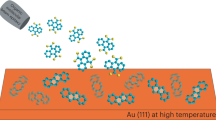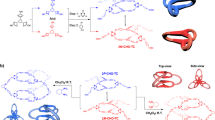Abstract
Odd and even homologues of some n-alkane-based systems are known to exhibit notably different trends in solid-state properties; a well-known illustration is the zigzag plot of their melting point versus chain length. Odd–even effects in the solid state often arise from intermolecular interactions that involve fully extended molecules. These effects have also been observed in less condensed phases, such as self-assembled monolayers; however, the origins of these effects in such systems can be difficult to determine. Here we combined NMR and computational analysis to show that all-syn contiguously methyl-substituted hydrocarbons, with chain lengths from C6 to C11, exhibit a dramatic odd–even effect in helical propensity. The even- and odd-numbered hydrocarbons populate regular and less-controlled helical conformations, respectively. This knowledge will guide the design of helical hydrocarbons as rigid scaffolds or as hydrophobic components in soft materials.
This is a preview of subscription content, access via your institution
Access options
Access Nature and 54 other Nature Portfolio journals
Get Nature+, our best-value online-access subscription
$29.99 / 30 days
cancel any time
Subscribe to this journal
Receive 12 print issues and online access
$259.00 per year
only $21.58 per issue
Buy this article
- Purchase on Springer Link
- Instant access to full article PDF
Prices may be subject to local taxes which are calculated during checkout




Similar content being viewed by others
Data availability
Crystallographic data for the structures reported in this article have been deposited at the Cambridge Crystallographic Data Centre, under deposition numbers CCDC 1908685 (14), 1908684 (18), 1908686 (C10), 1935492 (31), 1935491 (32) and 1935490 (36). Copies of the data can be obtained free of charge via https://www.ccdc.cam.ac.uk/structures/. All other data supporting the findings of this study are available within the article and its Supplementary Information, or from the corresponding author upon reasonable request.
Code availability
The Python script used in the computational study is included in the Supplementary Information file.
References
Baeyer, A. Ueber regelmässigkeiten im schmelzpunkt homologer verbindungen. Ber. Dtsch. Chem. Ges. 10, 1286–1288 (1877).
Boese, R., Weiss, H.-C. & Bläser, D. The melting point alternation in the short-chain n-alkanes: single-crystal X-ray analyses of propane at 30 K and of n-butane to n-nonane at 90 K. Angew. Chem. Int. Ed. 38, 988–992 (1999).
Bond, A. D. On the crystal structures and melting point alternation of the n-alkyl carboxylic acids. New J. Chem. 28, 104–114 (2004).
Tao, F. & Bernasek, S. L. Understanding odd−even effects in organic self-assembled monolayers. Chem. Rev. 107, 1408–1453 (2007).
Newcomb, L. B. et al. Odd–even effect in the hydrophobicity of n-alkanethiolate self-assembled monolayers depends upon the roughness of the substrate and the orientation of the terminal moiety. Langmuir 30, 11985–11992 (2014).
Baghbanzadeh, M. et al. Odd–even effects in charge transport across n-alkanethiolate-based SAMs. J. Am. Chem. Soc. 136, 16919–16925 (2014).
Jiang, L., Sangeeth, C. S. S. & Nijhuis, C. A. The origin of the odd–even effect in the tunneling rates across EGaIn junctions with self-assembled monolayers (SAMs) of n-alkanethiolates. J. Am. Chem. Soc. 137, 10659–10667 (2015).
Chen, J., Chang, B., Oyola-Reynoso, S., Wang, Z. & Thuo, M. Quantifying gauche defects and phase evolution in self-assembled monolayers through sessile drops. ACS Omega 2, 2072–2084 (2017).
Ramin, L. & Jabbarzadeh, A. Odd–even effects on the structure, stability, and phase transition of alkanethiol self-assembled monolayers. Langmuir 27, 9748–9759 (2011).
Chen, J. et al. Understanding interface (odd–even) effects in charge tunneling using a polished EGaIn electrode. Phys. Chem. Chem. Phys. 20, 4864–4878 (2018).
Xie, C. et al. Stretch-Induced coil–helix transition in isotactic polypropylene: a molecular dynamics simulation. Macromolecules 51, 3994–4002 (2018).
Stymiest, J. L., Dutheuil, G., Mahmood, A. & Aggarwal, V. K. Lithiated carbamates: chiral carbenoids for iterative homologation of boranes and boronic esters. Angew. Chem. Int. Ed. 46, 7491–7494 (2007).
Burns, M. et al. Assembly-line synthesis of organic molecules with tailored shapes. Nature 513, 183–188 (2014).
Hoffmann, R. W. Flexible molecules with defined shape—conformational design. Angew. Chem. Int. Ed. 31, 1124–1134 (1992).
Tsuzuki, S. et al. Investigation of intramolecular interactions in n-alkanes. Cooperative energy increments associated with GG and GTG′ sequences. J. Am. Chem. Soc. 113, 4665–4671 (1991).
Hoffmann, R. W., Stahl, M., Schopfer, U. & Frenking, G. Conformation design of hydrocarbon backbones: a modular approach. Chem. Eur. J. 4, 559–566 (1998).
Wechsel, R., Raftery, J., Cavagnat, D., Guichard, G. & Clayden, J. The meso helix: symmetry and symmetry-breaking in dynamic foldamers with reversible hydrogen-bond polarity. Angew. Chem. Int. Ed. 55, 9657–9661 (2016).
Tomsett, M. et al. A tendril perversion in a helical oligomer: trapping and characterizing a mobile screw-sense reversal. Chem. Sci. 8, 3007–3018 (2017).
Wang, Y., Noble, A., Myers, E. L. & Aggarwal, V. K. Enantiospecific alkynylation of alkylboronic esters. Angew. Chem. Int. Ed. 55, 4270–4274 (2016).
Morgan, J. B., Miller, S. P. & Morken, J. P. Rhodium-catalyzed enantioselective diboration of simple alkenes. J. Am. Chem. Soc. 125, 8702–8703 (2003).
Trudeau, S., Morgan, J. B., Shrestha, M. & Morken, J. P. Rh-catalyzed enantioselective diboration of simple alkenes: reaction development and substrate scope. J. Org. Chem. 70, 9538–9544 (2005).
Izumi, H., Yamagami, S., Futamura, S., Nafie, L. A. & Dukor, R. K. Direct observation of odd−even effect for chiral alkyl alcohols in solution using vibrational circular dichroism spectroscopy. J. Am. Chem. Soc. 126, 194–198 (2004).
Lüttschwager, N. O. B., Wassermann, T. N., Mata, R. A. & Suhm, M. A. The last globally stable extended alkane. Angew. Chem. Int. Ed. 52, 463–466 (2013).
Yang, K. et al. Dynamic odd–even effect in liquid n-alkanes near their melting points. Angew. Chem. Int. Ed. 55, 14090–14095 (2016).
Liu, B. et al. Polyfluorene (PF) single-chain conformation, β conformation, and its stability and chain aggregation by side-chain length change in the solution dynamic process. J. Phys. Chem. C 122, 14814–14826 (2018).
Acknowledgements
We thank H2020 ERC (670668) for financial support. We thank N. Pridmore and H. Sparkes for assistance with the X-ray analysis, M. Davey for useful discussions about VCD and W. Gerrard for his contribution to data processing. S.Z. thanks the EPSRC Bristol Chemical Synthesis Doctoral Training Centre for a studentship (EP/L015366/1). We thank S. Varga (Hungarian Academy of Sciences Research Centre for Natural Sciences) for supporting the VCD measurements. The work at Eötvös University was completed within the framework of the ELTE Excellence Program (1783-3/2018/FEKUTSTRAT) supported by the Hungarian Ministry of Human Capacities (EMMI).
Author information
Authors and Affiliations
Contributions
J.A.P. and S.Z. contributed equally to this work. V.K.A., C.P.B. and E.L.M. designed the project. J.A.P. conducted and designed the experiments and analysed the data. S.Z. conducted and designed the computational studies and NMR experiments. M.B. and G.T. performed the VCD experiments and analysed the data. J.A.P., S.Z., E.L.M., C.P.B. and V.K.A. wrote the manuscript.
Corresponding authors
Ethics declarations
Competing interests
The authors declare no competing interests.
Additional information
Publisher’s note Springer Nature remains neutral with regard to jurisdictional claims in published maps and institutional affiliations.
Supplementary information
Supplementary Information
Experimental procedures, experimental data, compound characterization data, computational procedures, NMR procedures, VCD data, NMR spectra and X-ray crystallography data.
XYZ coordinates
Instructions and Excel document including one worksheet for each compound studied computationally. Each worksheet contains the xyz coordinates of all conformers of that particular compound.
Crystallographic data
CIF for compound 14; CCDC reference 1908685.
Crystallographic data
CIF for compound 18; CCDC reference 1908684.
Crystallographic data
CIF for compound C10; CCDC reference 1908686.
Crystallographic data
CIF for compound 31; CCDC reference 1935492.
Crystallographic data
CIF for compound 32; CCDC reference 1935491.
Crystallographic data
CIF for compound 36; CCDC reference 1935490.
Rights and permissions
About this article
Cite this article
Pradeilles, J.A., Zhong, S., Baglyas, M. et al. Odd–even alternations in helical propensity of a homologous series of hydrocarbons. Nat. Chem. 12, 475–480 (2020). https://doi.org/10.1038/s41557-020-0429-0
Received:
Accepted:
Published:
Issue Date:
DOI: https://doi.org/10.1038/s41557-020-0429-0
This article is cited by
-
Iterative synthesis of 1,3-polyboronic esters with high stereocontrol and application to the synthesis of bahamaolide A
Nature Chemistry (2023)
-
Ensemble determination by NMR data deconvolution
Nature Reviews Chemistry (2023)



